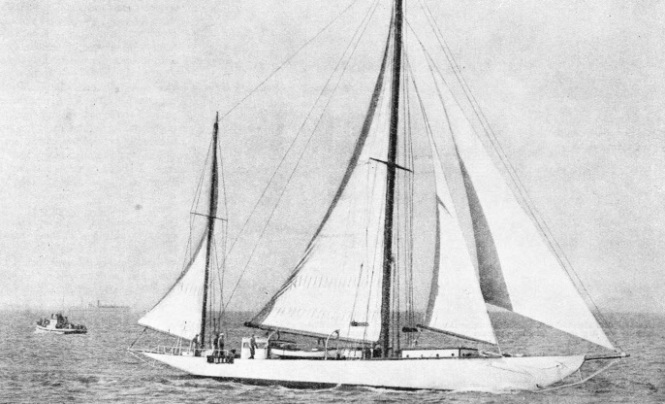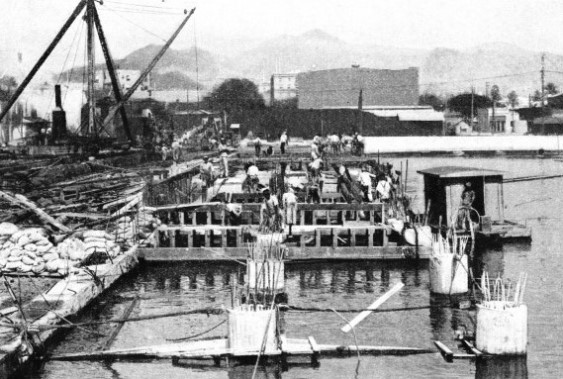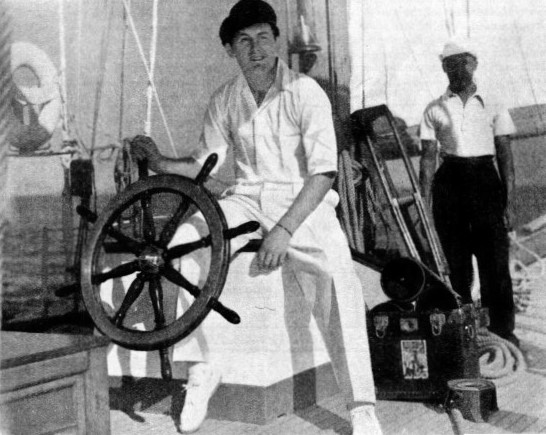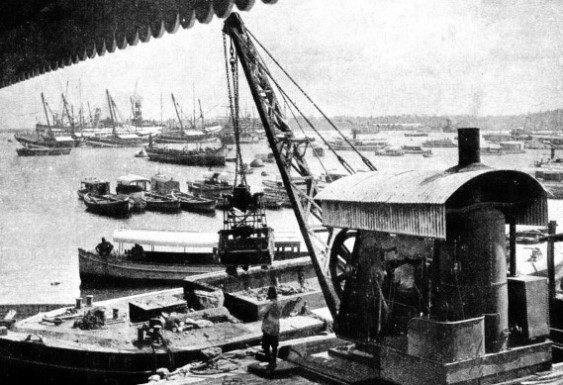

© Shipping Wonders of the World 2012-

Voyage of the “Athene”
The advantages of having sail as well as an auxiliary engine upon which to rely during a long ocean cruise are well demonstrated by the 18,000-
GREAT VOYAGES IN LITTLE SHIPS -

DESIGNED AS A RACING YACHT by Herreshoff in 1899, the Athene is an auxiliary yawl equipped as a floating film laboratory for Tay Garnett, the American film director. The Athene has an overall length of 105 feet and a water-
THE auxiliary yawl Athene arrived at Shoreham Harbour, Sussex, on June 25, 1936, having sailed over 18,000 miles from Los Angeles in almost exactly seven months. The Athene is of an unusual type for ocean cruising. She was built in 1899 as a defender of the America’s Cup. Her career has been extraordinarily varied, and her voyage from California to England is a noteworthy achievement in fore-
The yacht’s company of thirteen included a lady, Mrs. Tay Garnett, the wife of the owner, Mr. Tay Garnett, a prominent Hollywood film director, who made the voyage to photograph backgrounds of real scenery for film plays. The yacht is under the command of a professional mariner, Captain Asa J. Harris, and the crew is composed of sailors and film experts who are amateur seamen.
Yachts of the Athene’s type are built as racing machines, and are generally too hard on their gear and their crews for ocean cruising, the accommodation being too limited for comfort. When the challengers for the America’s Cup cross the Atlantic their spars and sails are reduced, but their lines are such that if heavy weather is encountered the men on board them have a wet and weary ordeal.
The Athene is 105 feet overall, and her length on the water-
The Athene is a thoroughbred, having been designed and built by Herreshoff at Bristol, Rhode Island, in 1899. She was one of the yachts built to defend the America’s Cup against the first of Sir Thomas Lipton’s Shamrocks. The Athene was defeated in the eliminating races and did not defend the Cup. Famous for her speed under sail, she was at one time a rum-
Her beam is 19 feet and her draught 13 feet. Her lead keel weighs thirty-

A VOYAGE OF 18,000 MILES was made by the auxiliary yawl Athene in just over seven months. She left San Pedro, the harbour of Los Angeles on November 24, 1935, and sighted Maui, an island of the Hawaiian group, on December 10. When she reached Honolulu she had sailed 2,356 miles in 17 days 20 hours. The Athene continued her voyage by way of Guam, Manila, Singapore, Colombo and the Suez Canal. Some 60,000 feet of film were used by the cinema experts on board. Finally the Athene reached Shoreham, Sussex, on June 25, 1936.

The Athene’s engine is a 50-
The hull is composite (wood and steel) and the yacht is not copper-
The Athene sailed from San Pedro, the harbour of Los Angeles, on November 24, 1935. Mr. Garnett’s motor yacht, the Katinka, escorted the Athene out of the harbour and, after she had saluted and turned back, the ship’s company were preparing to settle down when they had a surprise. A youthful stowaway was found in a half-
After this incident the ship’s company settled into the routine of sailing. The sea and the swell increased with the north-

HONOLULU HARBOUR, in the Hawaiian Islands, where the Athene was fitted with a new shaft and propeller in dry dock. Heavy concrete cylinders support the structures being built in connexion with Honolulu’s new concrete dock scheme. In the background are the mountains of Oahu.
An alarming mishap occurred on December 3. A shock was felt and the tailshaft broke outside the hull. The propeller carried away and sank into the depths of the ocean; the governor prevented the engine from racing, Shorn of her propeller, the yacht made good progress under sail, although the sea was heavy enough to trouble liners.
The first land sighted was the lofty peak, over 10,000 feet high, on the island of Maui. Off Honolulu a tug met the Athene and towed her into harbour for dry-
A new shaft and propeller were fitted and the Athene left Honolulu four days before Christmas in calm weather and under power, bound for Manila, about 5,000 miles away. The wind and sea increased and the rolling was so hard on the. spars and gear that on the first Sunday in the New Year the mainboom split near the gooseneck. It was fished (repaired) at sea, two battens each 12 feet long being lashed on either side of the boom.
The boom had taken severe punishment long before the damage was done, as, soon after she had left Honolulu, the yacht encountered heavy seas and the rolling was continuous. More than three weeks passed and over 3,000 miles were sailed. As stores and water were low, it was decided to call at the island of Guam, which is a United States naval base, if permission to enter could be obtained; the naval port is closed to other than U.S. naval vessels. The Athene wirelessed to the commander of the base, who in turn wirelessed to the United States, and permission to enter was granted. She arrived on January 15, having sailed 3,504 miles from Honolulu in 24 days 5 hours.

AT THE WHEEL of the Athene is Paul Schwegler, a former All-
The yacht sailed on January 22. As soon as she was clear of the island she encountered a confused sea and strong winds which sped her along at over 200 miles a day. She was struck by the tail of a typhoon and the going was rough. On January 23 she sailed 236 miles and made good 220 miles, her best run during the whole voyage. The following day she sailed 226 miles.
On the last day of the month a leak was reported, and it was feared that the heavy pounding had damaged the hull. The water was kept down, but the leak could not be located. Added to this trouble was anxiety due to the fact that the chart of the San Bernardino Strait could not be found. This strait is situated at the southern end of the long island of Luzon, upon which is Manila the capital of the Philippines. During the north-
Manila was reached on February 2. eleven days and two minutes out from Guam, the engine having been run for 170½ hours. The distance sailed was 1,878 miles. The leak and the missing chart were both located during the three days the Athene stayed at Manila. The pounding had stripped some bolts from the underside of the rudder stock. When these were replaced the leak gave no further trouble.
The Athene sailed from Manila on February 5 and set a course across the South China Sea for Saigon, in French Indo-
The Athene sailed for Colombo on March 15, and on the passage the engine checked with a noise as if the screw had struck some submerged object. Examination showed that two of the blades were bent, and it was decided to dry-
The damaged propeller was repaired, but if the clutch was placed in neutral and the propeller was allowed to revolve when the yacht was under sail, friction caused the bearing to become hot. The clutch had to be engaged, so that the propeller did not revolve, and this propeller drag slowed the yacht considerably. The yacht sailed on April 9, and made a passage of 960 miles to Bombay in 8 days 22 hours, under power most of the time. She arrived on April 19, after having visited two of the islands in the Laccadive group.

AT COLOMBO, CEYLON, the Athene was again put in dry dock for repairs to her propeller. There is no bar at Colombo, and the harbour has a water area of 643 acres at low tide. Vessels are moored to screw pile moorings within the shelter of breakwaters.
The next stage was across the Arabian Sea to Aden, a passage of 1,710 miles, sailed in 12 days 17 hours 24 minutes. The yacht left Bombay on April 25, and when she was some days out she was hailed by an Arab dhow. She hove-
The yacht stayed only for a few hours at Aden when she called on May 8. There were light airs, calms and strong squalls from all points of the compass during the passage up the Red Sea.
A Gale Off Sicily
The Athene reached Suez on May 19. the passage of 1,291 miles having occupied 10 days 22 hours 10 minutes. She then steamed through the Suez Canal to Port Said, taking 20 hours 10 minutes for the transit of 85 miles to Port Said, where she arrived on May 21. She used her engine almost all the way from Bombay to Port Said, and the owner intended to have her hauled out and the shaft inspected. The Canal Company wanted £150 to haul the yacht out of the water, so a diver was sent down to inspect the shaft.
The Athene left Port Said on May 23 on what proved to be a rough passage, encountering persistent headwinds. The Mediterranean is avoided by most sailing vessels making the world voyage, because of the uncertain winds. One day the yacht sailed 160 miles through the water, but travelled only ten miles on her course. The weather was so thick near Crete that the yacht had to wear to avoid going ashore. Later she encountered a heavy gale, sheltering for twelve hours in company with a steamship in the lee of the island of Pantelleria, south-
All on board were glad when the yacht reached Gibraltar, even though the stay was only for a few hours to replenish fuel and stores. She arrived there on June 12, having sailed 2,025 miles in fewer than 20 days.
Her next passage was to Calais, 1,283 miles away, which she reached on June 24 after 10 days 14¼ hours. She was off again the same night on her last passage of 82 miles to Shoreham Harbour, which she reached next day.
More than 18,000 miles had been sailed in just over seven months, in marked contrast to the length of time usually taken by auxiliary yachts. The long drag up the Red Sea to Suez and the uncertainties of the Mediterranean winds deter most owners of auxiliaries. The manner in which the yacht was kept moving is a credit to the owner and to the professional skill of Captain Asa J. Harris and also to the ability of the engineer, Mr. Edwin Katzer. Captain Harris had only two professional able seamen, and the fact that he brought the yacht all that distance with the aid of amateurs, some of whom had never been under sail before, is a tribute to him and to them.
That one propeller was lost and another was damaged at sea without the yacht being helpless indicates the risk taken by single-
Mr. Tay Garnett has achieved a feat which a number of people have attempted. Several yachtsmen have tried to combine a filming expedition with an ocean cruise under sail, and have failed either because of lack of knowledge of cinematography or because of yachting mishaps.
You can read more on “The America’s Cup”, “Auxiliary Sailing Vessels” and “Pidgeon and the Islander” on this website.